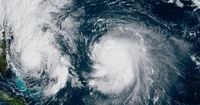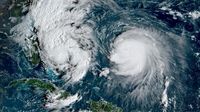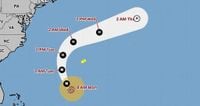As the Atlantic hurricane season barrels through its peak, a rare and potentially dangerous dance between two powerful storms—Tropical Storm Imelda and Hurricane Humberto—has captured the attention of meteorologists, coastal communities, and island nations alike. With both systems swirling in close proximity, their combined effects are already being felt from the Caribbean to the U.S. East Coast, and the coming days promise more drama as their paths and intensities continue to evolve.
According to the National Hurricane Center and coverage from CNN, Tropical Storm Imelda is forecast to intensify into a hurricane by Tuesday, September 30, 2025, as it tracks off the Southeast coast of the United States. Imelda’s approach is already kicking up dangerous surf, rip currents, coastal flooding, and beach erosion from Florida through the Carolinas, with rainfall totals expected to reach 2 to 6 inches along the coastal Carolinas through Tuesday. Meanwhile, Hurricane Humberto, which briefly exploded into a rare Category 5 storm with 160 mph winds on Saturday, is now a formidable Category 4 hurricane. Its massive circulation, just east of Imelda, is compounding hazards for U.S. beaches this week, driving deadly rip currents and big waves along much of the East Coast.
Even though Imelda’s center is expected to remain well offshore, its wide reach means that millions along the East Coast will still feel its effects. The National Hurricane Center cautioned, “The risk of significant wind impacts along the southeastern United States coast is decreasing, but interests in that area should continue to monitor the latest forecast updates.” That said, coastal flooding remains possible from Florida’s Space Coast to South Carolina, where onshore winds could push water 1 to 2 feet above normally dry ground at high tide.
In the Bahamas, the situation is even more urgent. As reported by the Associated Press, authorities closed most schools on Monday, September 29, and issued mandatory evacuations for some islands in the archipelago. Imelda, with sustained winds of 50 mph and moving north at 9 mph as of Monday, was located about 10 miles southeast of Great Abaco Island—a region still recovering from the devastation wrought by Hurricane Dorian in 2019. Power outages have been reported, government offices shuttered, and flights canceled until conditions improve. The Bahamas are bracing for 4 to 8 inches of rain through Tuesday, with a storm surge of 1 to 3 feet. Flash flooding and localized mudslides in higher terrain, especially in eastern Cuba, are also a real threat.
Humberto, for its part, is a Category 4 storm with maximum sustained winds of 145 mph and was located about 365 miles south-southwest of Bermuda, moving northwest at 14 mph. The Bermuda Weather Service has issued a tropical storm watch for the archipelago, and officials warn that Bermuda could face a rare one-two punch: Humberto is expected to pass west of the island as a Category 4 storm Monday into Tuesday, with Imelda potentially tracking even closer for a direct landfall Wednesday into Thursday.
Michael Weeks, Bermuda’s national security minister, didn’t mince words in a public warning: “Hurricane Humberto is a dangerous storm, and with another system developing to our south, every household in Bermuda should take the necessary steps to be prepared.” For Bermuda, two hurricanes in a week could deliver a punishing blow, even for these storm-hardened islands.
What makes this situation so unusual is the proximity of the two storms. Meteorologists are closely watching for the Fujiwhara effect—a rare phenomenon in the Atlantic basin where two cyclones orbit around a common center, influencing each other’s paths and intensities. Alex DaSilva, lead hurricane expert for AccuWeather, explained to the Associated Press, “It’s a very rare phenomena overall in the Atlantic basin.” The Fujiwhara effect is more common in the Pacific, but when it occurs in the Atlantic, it can cause storms to either spin around each other or, in rare cases, merge into a single, more powerful system.
This anticipated interaction is already shaping the forecast. Imelda’s slower than expected northward movement means Humberto will “win the tropical tug-of-war and pull Imelda away from the shoreline,” as CNN meteorologists put it. The result is a decreasing risk of damaging winds and flooding rains for the U.S. coast, but a heightened threat for Bermuda and the Bahamas. Still, officials in the Southeast U.S. have not been caught flat-footed: South Carolina Governor Henry McMaster issued a state of emergency on Friday, activating statewide response plans, while the City of Charleston declared a local state of emergency on Saturday and began distributing sandbags and clearing storm drains. North Carolina Governor Josh Stein also declared a state of emergency to mobilize resources.
Despite the shifting tracks, the impacts of both storms are significant. Dangerous surf and heavy rip currents are expected all week along the East Coast, with high surf warnings in effect from Florida to the Carolinas. Localized flash flooding is possible, especially in low-lying and urban areas along the coast. The Bahamas and eastern Cuba remain under tropical storm warnings, with the risk of mudslides in mountainous terrain.
So far in 2025, the United States has managed to avoid a direct hurricane landfall—a remarkable streak, considering the season’s ferocity. Tropical Storm Chantal came ashore in South Carolina in July, but no hurricanes have reached the coast at hurricane strength. If this streak holds, it would be the first season without a hurricane coming ashore in a decade, according to The New York Times. Yet, this season has been remarkable in another way: every hurricane so far—Erin, Gabrielle, and Humberto—has rapidly intensified to major hurricane strength (Category 3 or higher), a feat not seen this early since 1935.
Rapid intensification, where a storm’s sustained winds increase by at least 35 mph in 24 hours, has become increasingly common. Experts point to warmer ocean temperatures, driven by fossil fuel pollution and climate change, as a key factor. “High sea surface temperatures can provide the energy necessary for such growth,” noted The New York Times, referencing recent storms like Otis and Milton that shocked forecasters with their explosive development.
In the Caribbean and along the U.S. coast, residents and officials are taking no chances. Mandatory evacuation orders remain in effect for parts of the northern Bahamas, shelters have been activated on New Providence, and search and rescue teams are on standby in the Carolinas. The National Hurricane Center continues to urge vigilance, especially as the forecast remains fluid and the possibility of unpredictable interactions between Imelda and Humberto looms.
For now, the Atlantic remains restless. As Imelda and Humberto swirl in their rare Fujiwhara dance, coastal communities from the Caribbean to Bermuda and the U.S. East Coast are reminded once again of the power—and unpredictability—of hurricane season.






